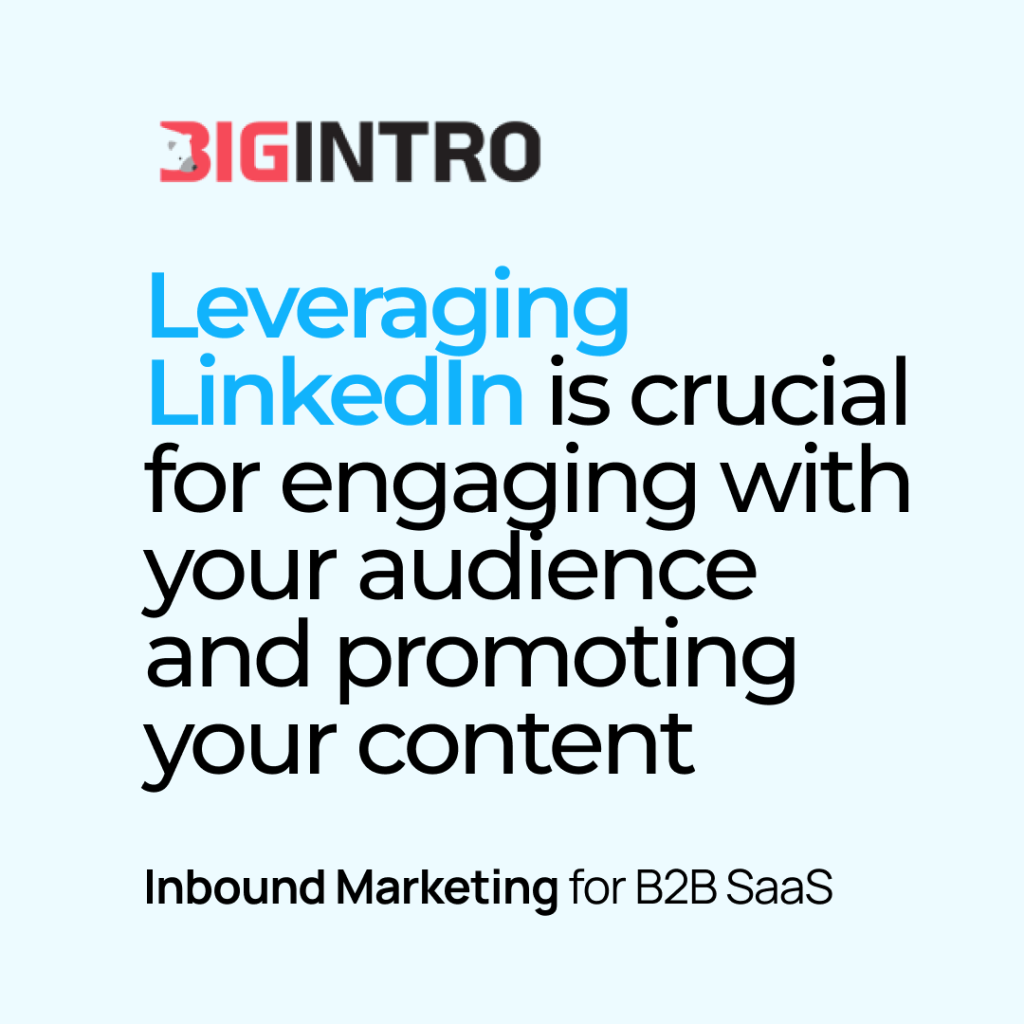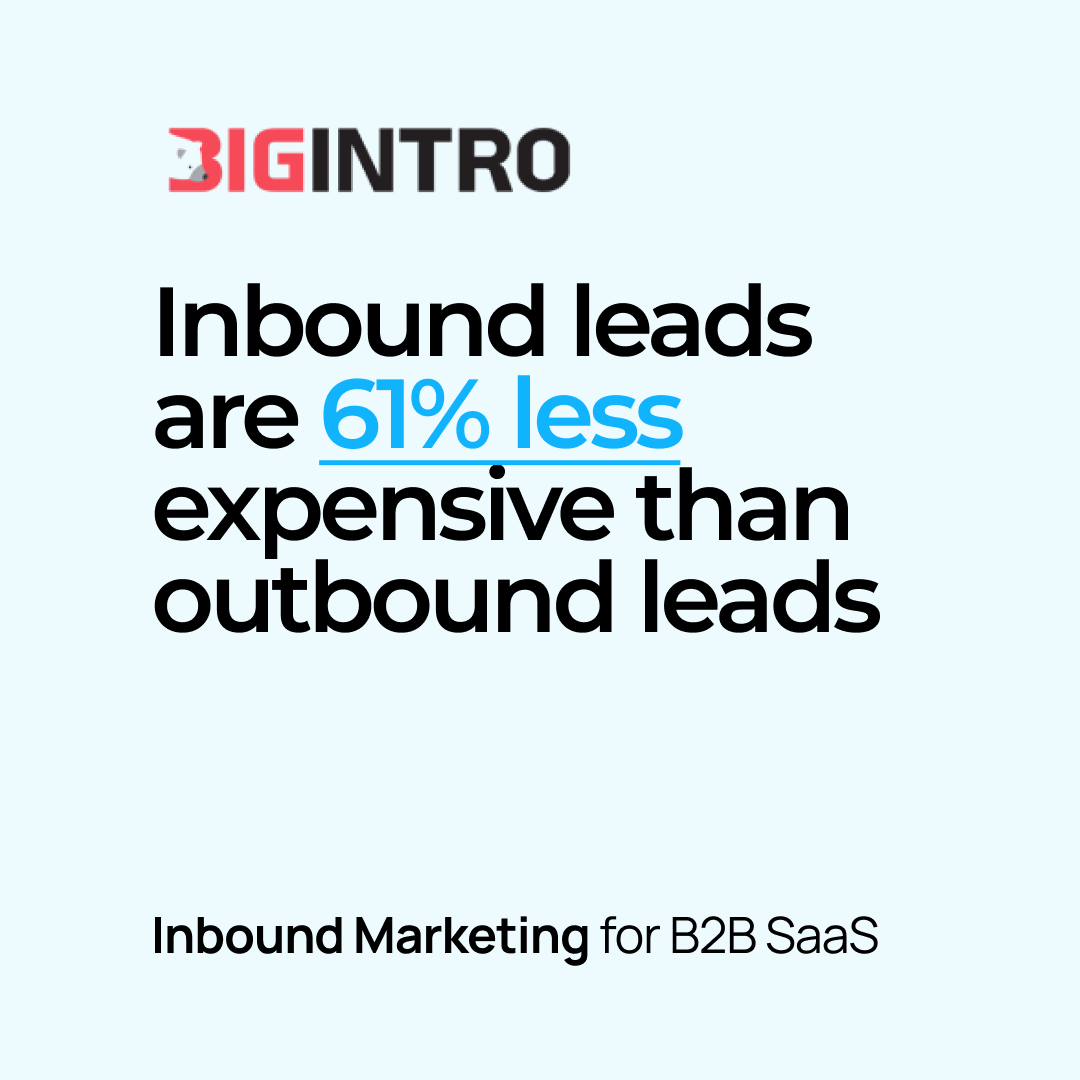Picture this: You’ve built a fantastic B2B SaaS product that could revolutionize the way businesses operate. But there’s a catch – your potential customers are scattered across the digital landscape, and traditional marketing tactics just aren’t cutting it.
Cold emails are rarely read; highly sought-after leads are bombarded with cold emails every day, making the tactic ineffective. Most cold emails end up in users’ spam bins, never to be seen again. Targeted ads are expensive; bidding wars drive up the cost of targeted ads, sometimes so significantly they price out many small businesses. Users are also increasingly using adblockers, making targeted ads ineffective.
How do you draw them in, keep them engaged, and turn them into loyal advocates? That’s where inbound marketing comes into play. Instead of pushing your product onto people, you create valuable content and experiences that naturally attract them to you.
For B2B SaaS companies, this approach is a game-changer. Not only does it help you attract new customers, but it also keeps them coming back for more, encouraging upselling and retention. Let’s dive into ten proven inbound marketing strategies that can help your B2B SaaS business thrive.
Not only does inbound marketing help you attract new customers, but it also keeps them coming back for more, encouraging upselling and retention. Let’s dive into ten proven inbound marketing strategies that can help your B2B SaaS business thrive.
1. Content Marketing
Creating high-quality, valuable content is the cornerstone of any successful inbound marketing strategy. Imagine you’re producing a blockbuster movie for your audience – it needs to educate, inform, and solve their problems. Start by conducting detailed user research. This involves identifying who is using your product and who is consuming your content. Building personas around your users’ roles, needs, pain points, missions, and values helps in creating content that resonates with them.
Once you have a clear understanding of your audience, keyword research becomes crucial. By identifying the keywords your audience uses to search for solutions, you can optimize your content to rank higher on search engines.
Additionally, performing a SWOT analysis on your competitors can reveal opportunities and threats, helping you create content that stands out. Types of content that work well include blogs, whitepapers, eBooks, and case studies, each offering unique value to different segments of your audience.
Takeaways:
- Invest time in understanding your audience through detailed user research.
- Use SEO techniques, including keyword research, to increase content visibility.
- Learn from your competitors by conducting a SWOT analysis.
2. SEO (Search Engine Optimization)
Think of SEO as the map that guides potential customers to your treasure trove of content. It’s essential for ensuring that your content is discoverable by your target audience. This involves both on-page and off-page techniques.
On-page SEO focuses on optimizing individual pages on your website. This includes using relevant keywords in your content, optimizing meta descriptions and headers, and ensuring your site’s structure is search-engine friendly. Off-page SEO, on the other hand, involves activities outside your website that influence your rankings, such as building backlinks and creating a robust internal linking structure.
Also, targeting long-tail keywords is another essential aspect of an effective SEO strategy. Long-tail keywords are more specific phrases that users are more likely to convert on because they reflect a higher intent to purchase or learn about a particular topic. By focusing on these keywords, you can attract more specific and higher-converting traffic to your site. Implementing an SEO strategy that covers both on-page and off-page techniques and targets long-tail keywords can significantly enhance your visibility and attract quality leads.
Takeaways:
- Implement a comprehensive SEO strategy that includes both on-page and off-page techniques.
- Use long-tail keywords to attract more specific and higher-converting traffic.
- Continuously optimize your content to stay ahead in search engine rankings
3. Marketing on LinkedIn
Leveraging LinkedIn is crucial for engaging with your audience and promoting your content. LinkedIn offers a unique opportunity to interact directly with your audience, gather feedback, and build a community around your brand. As the go-to platform for B2B networking, LinkedIn is a powerful tool for connecting with industry professionals, sharing thought leadership content, and establishing your brand’s authority.

Engagement is key on LinkedIn. Actively participate in industry-related groups and communities to build relationships and showcase your expertise. Share valuable content, respond to comments, and engage in discussions. Additionally, stay updated with new LinkedIn features, such as LinkedIn Live, LinkedIn Stories, and the platform’s algorithm changes, to maximize your reach and engagement.
Takeaways:
- Focus on LinkedIn as your primary social media platform for B2B engagement.
- Actively participate in LinkedIn groups and communities to build relationships and establish authority.
- Stay updated with new LinkedIn features and leverage them to enhance your content’s visibility and reach.
4. Email Marketing
Email marketing remains one of the most effective ways to nurture leads and convert prospects into customers. Personalized email campaigns are essential for B2B SaaS companies, as they allow you to tailor your messaging to different segments of your audience. Start by hyper-segmenting your email lists based on factors such as job roles, industry, and previous interactions with your brand. This ensures that your emails are relevant and engaging for each recipient.
Creating compelling email content involves writing clear and attention-grabbing subject lines, providing valuable and concise information, and including strong calls to action. It is also important to make your emails mobile-friendly, as many professionals check their emails on mobile devices. Automating your email marketing campaigns can save time and ensure that your messages are sent at optimal times. Use marketing automation tools to set up workflows that nurture leads through the sales funnel and keep your audience engaged.
Takeaways:
- Hyper-segment your email lists to ensure personalized and relevant messaging.
- Write compelling email content with clear subject lines and strong calls to action.
- Use marketing automation tools to streamline your email campaigns and nurture lead.
5. Webinars and Live Events
Hosting webinars and live events is an excellent way to provide value to your audience and establish your company as an authority in your industry. Webinars offer a platform to share in-depth knowledge, demonstrate your product’s capabilities, and engage with potential customers in real-time. When planning a webinar, choose topics that address common pain points and questions your audience may have. Promote your webinars through various channels, including email, social media, and your website, to maximize attendance.
Live events, whether online or in-person, also provide opportunities for networking and relationship-building. Collaborate with industry experts and influencers to co-host events, which can help expand your reach and credibility. Ensure that your events are interactive by including Q&A sessions, polls, and live demos to keep your audience engaged. Follow up with attendees after the event with additional resources and information to nurture these leads further.
Takeaways:
- Host webinars on topics that address your audience’s pain points and questions.
- Promote webinars and live events through multiple channels to maximize attendance.
- Collaborate with industry experts and influencers to enhance credibility and reach.
6. Influencer Marketing
Partnering with industry influencers can significantly amplify your reach and credibility. Influencers have established trust with their audience, and their endorsement can lead to increased awareness and interest in your product. Start by identifying influencers who align with your brand values and have a following that matches your target audience. Build genuine relationships with these influencers by engaging with their content and offering value beyond just your product.
When collaborating with influencers, provide clear deliverables and expectations. This can include co-branded content, product reviews, or social media takeovers. It’s important to respect their creative process and provide compensation that reflects their work’s value. Influencers can help create authentic and engaging content that resonates with your audience and drives conversions.
Takeaways:
- Identify and partner with influencers who align with your brand values.
- Build genuine relationships with influencers by engaging with their content.
- Provide clear deliverables and fair compensation to ensure effective collaborations.
7. Customer Testimonials and Case Studies
Showcasing customer success stories through testimonials and case studies is a powerful way to build trust and credibility. Potential customers are more likely to trust the experiences of their peers than promotional content from your company. Collect testimonials from satisfied customers and highlight specific results and benefits they have experienced using your product. These testimonials can be featured on your website, social media, and marketing materials.
Case studies offer a more in-depth look at how your product has helped customers overcome specific challenges and achieve their goals. Create detailed case studies that include the customer’s background, the challenges they faced, the solutions provided by your product, and the measurable results. Use visuals, quotes, and data to make your case studies compelling and easy to understand. By showcasing real-world examples of your product’s effectiveness, you can build trust with potential customers and encourage them to take the next step.
Takeaways:
- Collect and highlight customer testimonials that showcase specific results and benefits.
- Create detailed case studies that demonstrate your product’s effectiveness
- Use visuals, quotes, and data to make your case studies compelling.
8. Lead Nurturing and Automation
Lead nurturing is essential for guiding prospects through the sales funnel and converting them into customers. Marketing automation tools can help streamline this process by creating workflows that deliver personalized content based on the lead’s behavior and stage in the buyer’s journey. Start by mapping out your lead nurturing process, identifying key touchpoints where you can provide value and move leads closer to a purchase decision.
Did you know? Inbound leads are 61% less expensive than outbound leads, and three out of four inbound marketing channels incur lower costs than any outbound channels?

Use automation to send targeted emails, offer relevant content, and trigger actions based on the lead’s interactions with your brand. Personalization is key in lead nurturing, as it helps build a connection with your prospects and addresses their specific needs and concerns. Regularly review and optimize your workflows to ensure they are effective in moving leads through the funnel and converting them into customers.
Takeaways:
- Map out your lead nurturing process and identify key touchpoints.
- Use marketing automation tools to deliver personalized content and trigger actions.
- Regularly review and optimize your workflows for maximum effectiveness.
9. Analytics and Data-Driven Marketing
Tracking and measuring the performance of your marketing efforts is crucial for making data-driven decisions and optimizing your strategies. Set clear KPIs that align with your business goals and regularly monitor your progress. Key metrics to track include website traffic, conversion rates, email open and click-through rates, social media engagement, lead generation, and ROI.
Important Metrics and KPIs to Track:
- Website Traffic: Monitor the number of visitors to your site, their behavior, and the sources of your traffic. Use tools like Google Analytics to track page views, session duration, bounce rates, and unique visitors. Aim for a monthly increase of at least 10% in unique visitors.
- Conversion Rates: Track how many visitors take the desired action on your site, such as signing up for a newsletter or completing a purchase. Calculate conversion rates by dividing the number of conversions by the total number of visitors. A target conversion rate for B2B SaaS can be around 2-5%.
- Email Open and Click-Through Rates: Measure the effectiveness of your email campaigns by tracking how many recipients open your emails and click on the links. Tools like Mailchimp or HubSpot can provide these metrics. Aim for an open rate of 20-30% and a click-through rate of 2-5%.
- Social Media Engagement: Track likes, shares, comments, and overall engagement on your social media posts. LinkedIn Analytics can give you detailed insights into your engagement levels and audience demographics. Set a goal to increase your engagement rate by 5-10% monthly.
- Lead Generation: Monitor the number of new leads generated through your marketing efforts. Track form submissions, downloads of gated content, and sign-ups for webinars. Aim to increase new leads by 15-20% each quarter.
- Opportunities: Track the number of marketing-qualified leads (MQLs) that transition into sales-qualified leads (SQLs) and eventually opportunities. Set a goal for a 10-15% increase in opportunities generated from MQLs.
- Return on Investment (ROI): Calculate the ROI of your marketing campaigns by comparing the revenue generated from your marketing efforts to the costs incurred. Use the formula: ROI = (Revenue – Cost) / Cost. Aim for an ROI of at least 3:1, meaning $3 generated for every $1 spent.
Use analytics tools to gather insights into your audience’s behavior and preferences. This data can help you identify what’s working, what’s not, and where there are opportunities for improvement. Make data-driven adjustments to your campaigns to enhance their effectiveness and achieve better results. By continuously analyzing and optimizing your marketing efforts, you can ensure that your strategies are aligned with your business objectives and driving growth.
Takeaways:
- Set clear KPIs and regularly monitor your marketing performance.
- Use analytics tools to gather insights into audience behavior and preferences.
- Make data-driven adjustments to optimize your marketing strategies.
10. Account-Based Marketing (ABM)
Account-based marketing (ABM) is a personalized approach that targets specific accounts with tailored marketing efforts. This strategy is particularly effective for B2B SaaS companies looking to land high-value clients. ABM involves close collaboration between marketing and sales teams to identify target accounts, develop personalized campaigns, and engage decision-makers.
Start by identifying key accounts that are a good fit for your product. Research these accounts thoroughly to understand their pain points, goals, and decision-making processes. Develop personalized content and campaigns that address their specific needs and demonstrate how your product can help them achieve their objectives. Use a combination of email, social media, and direct outreach to engage with decision-makers and build relationships. By focusing on high-value accounts, ABM can lead to higher conversion rates and more significant business opportunities.
Takeaways:
- Identify and research key accounts that are a good fit for your product.
- Develop personalized content and campaigns to address specific needs.
- Collaborate with sales teams to engage decision-makers and build relationships.
Bonus: Employee Advocacy
Employee advocacy is one of the more affordable B2B inbound marketing strategies. It leverages the social audiences of your employees to gain more awareness and leads for your brand. When employees share their genuine experiences and insights about your product, it resonates more authentically with their networks.
For instance, consider how the head of content for Lavender (an AI-powered tool for writing sales emails) discusses the core value of the tool on LinkedIn. The writing style and message of the post are so compelling that it comes across as helpful and interesting instead of overly promotional. This approach not only increases brand awareness but also builds trust and credibility.
To emulate this strategy, encourage your employees to create their own posts that challenge common beliefs or offer fresh perspectives. We don’t mean controversial in the typical sense of the word, but rather posts that contradict a common saying or belief. This is a surefire way to get more engagement and drive meaningful conversations.
Takeaways:
- Leverage employee advocacy as an affordable inbound marketing strategy.
- Encourage employees to share genuine insights and experiences about your product.
- Craft posts that offer fresh perspectives or challenge common beliefs to boost engagement.
Conclusion
Inbound marketing is a powerful approach for B2B SaaS companies looking to attract, engage, and retain customers. By implementing these ten strategies, you can create valuable content, optimize your online presence, and build strong relationships with your audience. Remember to continuously monitor and optimize your efforts to stay ahead in the competitive SaaS landscape. Start implementing these strategies today and watch your business grow.
Ready to take your B2B SaaS marketing to the next level? Sign up for our newsletter for more tips and insights, or contact us for a personalized consultation.












